Compute Network And Security Analysis
Added on 2022-08-14
22 Pages3456 Words9 Views
COMPUTER AND NETWORK SECURITY 0
Computer Network and
Security
Computer Network and
Security

COMPUTER NETWORK AND SECURITY 1
Table of Contents
Task 1: CCCU FM radio catch-up service....................................................................2
Analog to digital conversion.................................................................................... 2
Causes of noise/error.............................................................................................. 4
The solution to the radio station's problem.............................................................5
Task 2: Modulation..................................................................................................... 6
AM modulation........................................................................................................ 6
Advantages of AM................................................................................................ 7
Disadvantages of AM............................................................................................ 8
FM modulation......................................................................................................... 8
Advantages of FM................................................................................................. 9
Disadvantages of FM............................................................................................ 9
Comparison between AM and FM..........................................................................10
Task 3: Hubs and switches....................................................................................... 11
References............................................................................................................... 17
Table of Contents
Task 1: CCCU FM radio catch-up service....................................................................2
Analog to digital conversion.................................................................................... 2
Causes of noise/error.............................................................................................. 4
The solution to the radio station's problem.............................................................5
Task 2: Modulation..................................................................................................... 6
AM modulation........................................................................................................ 6
Advantages of AM................................................................................................ 7
Disadvantages of AM............................................................................................ 8
FM modulation......................................................................................................... 8
Advantages of FM................................................................................................. 9
Disadvantages of FM............................................................................................ 9
Comparison between AM and FM..........................................................................10
Task 3: Hubs and switches....................................................................................... 11
References............................................................................................................... 17
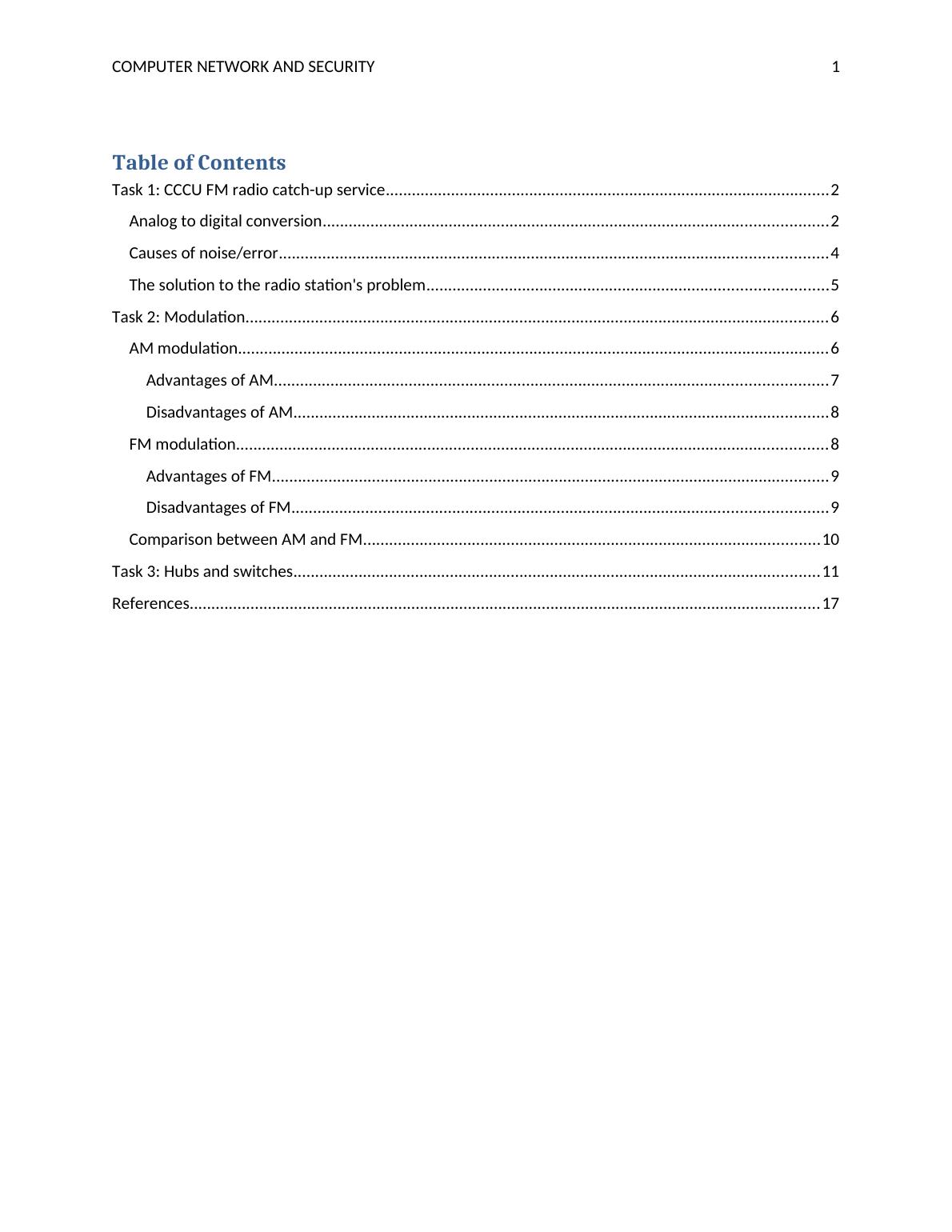
COMPUTER NETWORK AND SECURITY 2
Task 1: CCCU FM radio catch-up service
As per the given task, the CCU FM radio station is operated on the
fundamental of analog technology that helps to perform communication in a
reliable manner. ADC is defined as the analog to digital converter which is
mainly used to convert the transmitted signal in the form of digits or codes.
For performing operations of the CCCU FM station, it is significant to
perform the digital conversion process in an effective manner. This task
focuses on the analog to digital conversion and identifies the risk factors
that impact on the performance of developed systems.
Analog to digital conversion
In the field of electronics, analog to digital converter (ADC) is defined as a
communication system that has the potential to converts an analog signal
including sound into digital signals including 0 and 1. It is an effective
approach used in the communication systems for managing conflicts and
data transferring issues in a reliable manner. Mehdizadeh, et al., (2017-I)
examined that the ADC system is capable to deliver an isolated
measurement including an electronic system that can help companies to
convert an input signal into the digital signal by representing the magnitude
of the current and voltage.
Mainly, in the CCCU FM radio system, the transmitted signal need to be
converted in digital numbers in order to transfer the effective signals to the
receiver. It is true that an ADC performs the functions by which the
receivers can obtain the effective outputs and address the communication-
related issues. From the recent study, it is found that ADC is capable to
provide effective outputs in the communication channel due to which it is
utilized in the FM radio system. The below figure shows the working
operations of ADC convert in which analog signal is added to the ADC
converter and receiver obtain a digital signal that contains digital numbers
in order to perform data communication effectively:
Task 1: CCCU FM radio catch-up service
As per the given task, the CCU FM radio station is operated on the
fundamental of analog technology that helps to perform communication in a
reliable manner. ADC is defined as the analog to digital converter which is
mainly used to convert the transmitted signal in the form of digits or codes.
For performing operations of the CCCU FM station, it is significant to
perform the digital conversion process in an effective manner. This task
focuses on the analog to digital conversion and identifies the risk factors
that impact on the performance of developed systems.
Analog to digital conversion
In the field of electronics, analog to digital converter (ADC) is defined as a
communication system that has the potential to converts an analog signal
including sound into digital signals including 0 and 1. It is an effective
approach used in the communication systems for managing conflicts and
data transferring issues in a reliable manner. Mehdizadeh, et al., (2017-I)
examined that the ADC system is capable to deliver an isolated
measurement including an electronic system that can help companies to
convert an input signal into the digital signal by representing the magnitude
of the current and voltage.
Mainly, in the CCCU FM radio system, the transmitted signal need to be
converted in digital numbers in order to transfer the effective signals to the
receiver. It is true that an ADC performs the functions by which the
receivers can obtain the effective outputs and address the communication-
related issues. From the recent study, it is found that ADC is capable to
provide effective outputs in the communication channel due to which it is
utilized in the FM radio system. The below figure shows the working
operations of ADC convert in which analog signal is added to the ADC
converter and receiver obtain a digital signal that contains digital numbers
in order to perform data communication effectively:
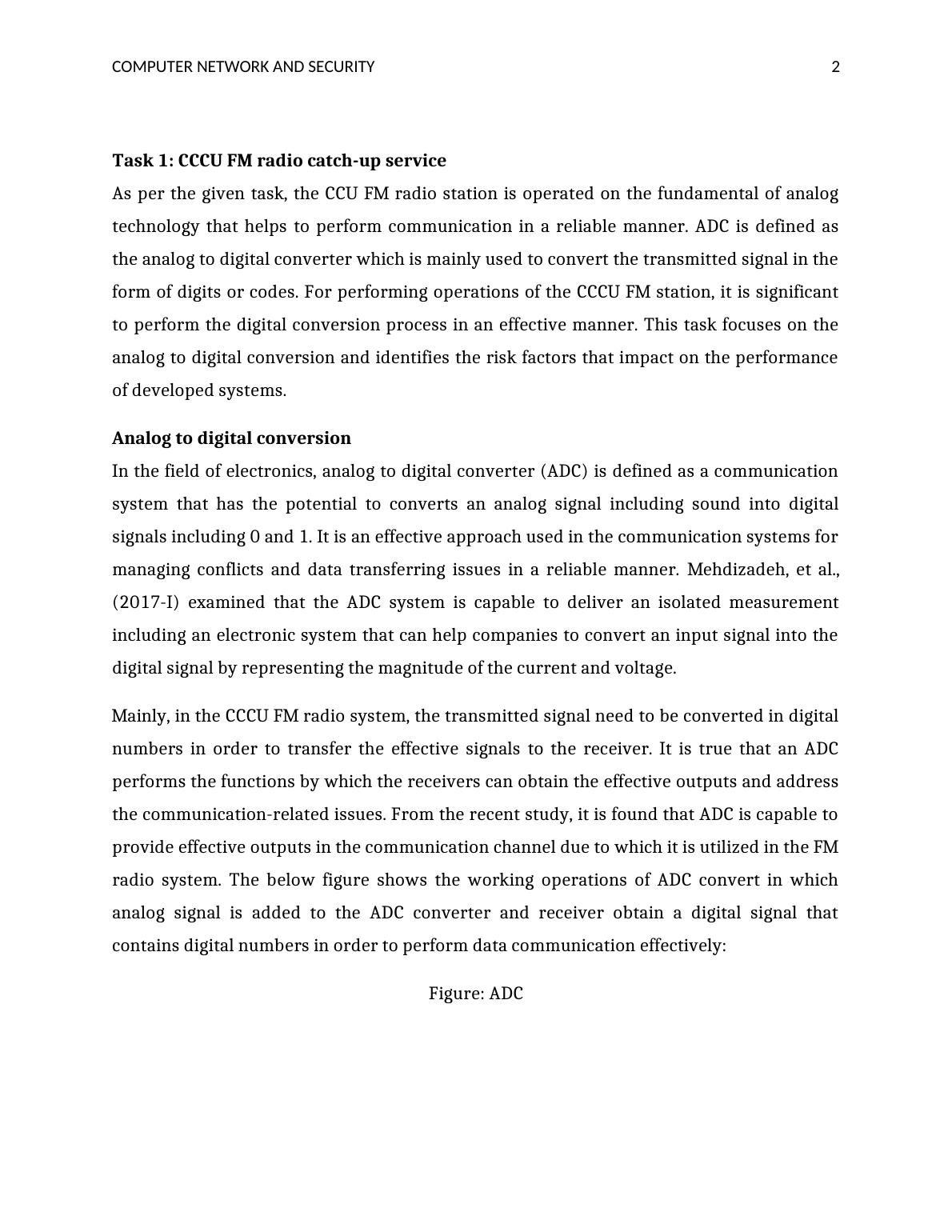
COMPUTER NETWORK AND SECURITY 3
Figure: ADC
(Youssefi, et al., 2012)
There are various kinds of techniques involve in the ADV convert that are
highlighted below:
Pulse code modulation
Delta modulation
Adaptive delta modulation
In which pulse code modulation is an effective technique that encodes the
signal using sampling or quantization or encoding methods. Using a low
pass filter, the ADC system can eliminate the larger frequency signals in
order to ensure the input signal is free from the unwanted components of
the frequencies. PCM is more complex due to which it is not used in the FM
radio system but delta modulation is appropriate which is capable to deliver
effective services to the consumers (Mehdizadeh, et al., 2017-II).
The performance of delta modulation may be enhanced with the help of step
size. In the case of adaptive delta modulation, the sample size is adapted as
per the input signal. Therefore, it is reported that using adaptive delta
modulation the working operation of the ADC converter can be performed
in a reliable manner. Laghezza, et al., (2013) examined that the adaptive
delta modulation provides a way where consumers can use sample size as
per the developed system in order to manage complexity and reduce the
Figure: ADC
(Youssefi, et al., 2012)
There are various kinds of techniques involve in the ADV convert that are
highlighted below:
Pulse code modulation
Delta modulation
Adaptive delta modulation
In which pulse code modulation is an effective technique that encodes the
signal using sampling or quantization or encoding methods. Using a low
pass filter, the ADC system can eliminate the larger frequency signals in
order to ensure the input signal is free from the unwanted components of
the frequencies. PCM is more complex due to which it is not used in the FM
radio system but delta modulation is appropriate which is capable to deliver
effective services to the consumers (Mehdizadeh, et al., 2017-II).
The performance of delta modulation may be enhanced with the help of step
size. In the case of adaptive delta modulation, the sample size is adapted as
per the input signal. Therefore, it is reported that using adaptive delta
modulation the working operation of the ADC converter can be performed
in a reliable manner. Laghezza, et al., (2013) examined that the adaptive
delta modulation provides a way where consumers can use sample size as
per the developed system in order to manage complexity and reduce the
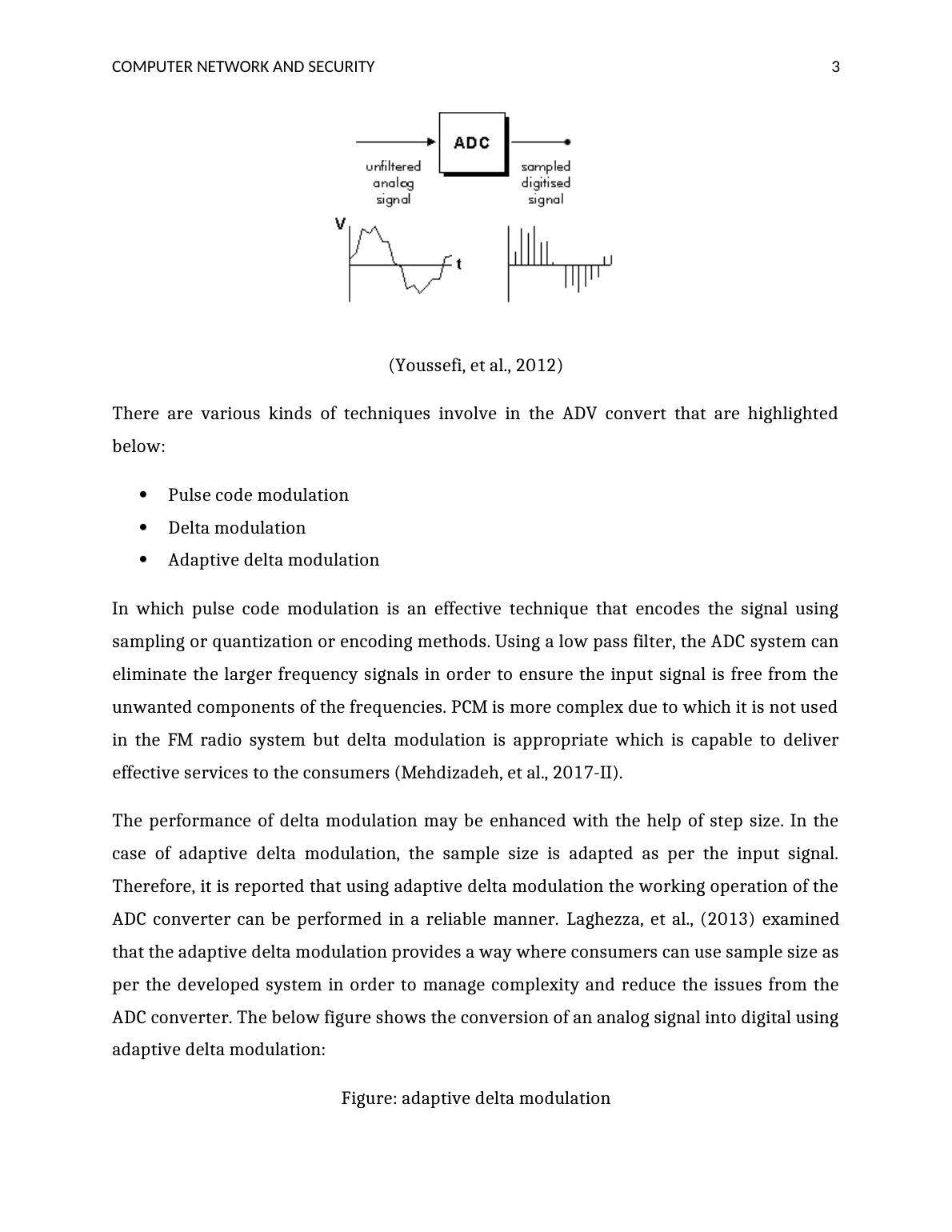
COMPUTER NETWORK AND SECURITY 4
issues from the ADC converter. The below figure shows the conversion of an
analog signal into digital using adaptive delta modulation:
Figure: adaptive delta modulation
(Source: Ng, et al., 2012)
It is found that the performance of an ADC convert can be evaluated with
the help of SNR and bandwidth. The SNR is mainly affected by the accuracy
and resolution and bandwidth is influenced using sampling rate. Therefore,
it is significant to focus on bandwidth and SNR value while implementing
the ADC system into the CCCU FM radio. There are various errors occur in
the analog to digital converter that directly impacts on the performance of
the communication system and the receiver is not able to receive effective
output. These errors include noise error, quantization error and many more.
Causes of noise/error
Noise is a major issue linked with the ADC converter that impacts on the
transmitted signal and reduces the performance of data communication in
the CCCU FM radio. The major cause of noise error is that it disturbs the
converted digital signal that means the user is not able to obtain the
effective output. The presence of noise error in the signal can produce
barriers for the users as noise signals mix with the transmitted signals that
affect the overall performance of the communication channels in the ADC
issues from the ADC converter. The below figure shows the conversion of an
analog signal into digital using adaptive delta modulation:
Figure: adaptive delta modulation
(Source: Ng, et al., 2012)
It is found that the performance of an ADC convert can be evaluated with
the help of SNR and bandwidth. The SNR is mainly affected by the accuracy
and resolution and bandwidth is influenced using sampling rate. Therefore,
it is significant to focus on bandwidth and SNR value while implementing
the ADC system into the CCCU FM radio. There are various errors occur in
the analog to digital converter that directly impacts on the performance of
the communication system and the receiver is not able to receive effective
output. These errors include noise error, quantization error and many more.
Causes of noise/error
Noise is a major issue linked with the ADC converter that impacts on the
transmitted signal and reduces the performance of data communication in
the CCCU FM radio. The major cause of noise error is that it disturbs the
converted digital signal that means the user is not able to obtain the
effective output. The presence of noise error in the signal can produce
barriers for the users as noise signals mix with the transmitted signals that
affect the overall performance of the communication channels in the ADC
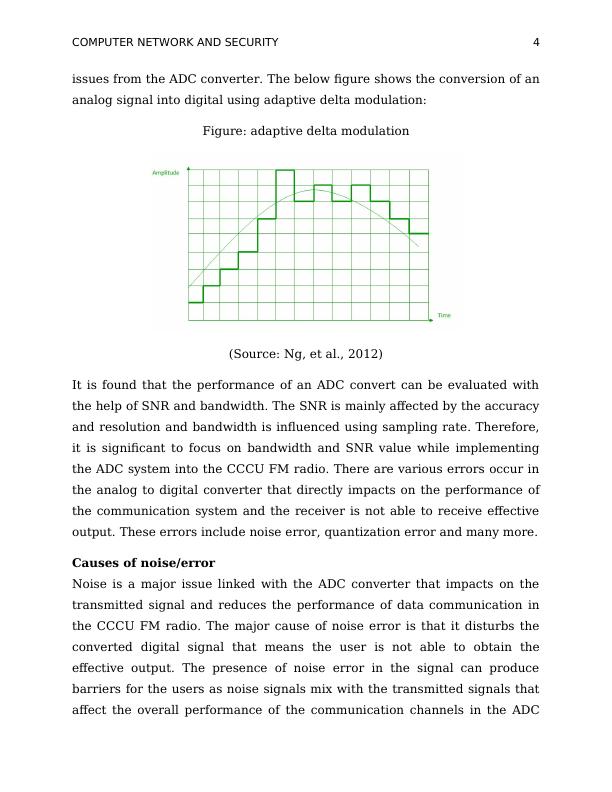
COMPUTER NETWORK AND SECURITY 5
converter. Wiberg, et al., (2012) provided their opinions on ADC and
determined that both noise and distortion are major problems that occur in
the conversion and data transmission process. The below screenshot
highlights the transmitted signal with some noise:
Figure: conversion of an analog signal in Audacity
(Source: By Author)
There are various kinds of noise errors that occur in the analog to digital
converters including thermal noise, shot noise, flicker noise, burst and many
more. It is observed that in the context of the ADC converter, noise signals
can introduce unwanted larger frequency signals into the analog signal that
may disrupt the entire signal as the sample rate is not capable to manage
the added noise signals. Therefore, it is significant to manage such errors
from the communication systems in order to obtain effective outputs using
the ADC converter and reduce the unwanted errors from the
communication system.
converter. Wiberg, et al., (2012) provided their opinions on ADC and
determined that both noise and distortion are major problems that occur in
the conversion and data transmission process. The below screenshot
highlights the transmitted signal with some noise:
Figure: conversion of an analog signal in Audacity
(Source: By Author)
There are various kinds of noise errors that occur in the analog to digital
converters including thermal noise, shot noise, flicker noise, burst and many
more. It is observed that in the context of the ADC converter, noise signals
can introduce unwanted larger frequency signals into the analog signal that
may disrupt the entire signal as the sample rate is not capable to manage
the added noise signals. Therefore, it is significant to manage such errors
from the communication systems in order to obtain effective outputs using
the ADC converter and reduce the unwanted errors from the
communication system.
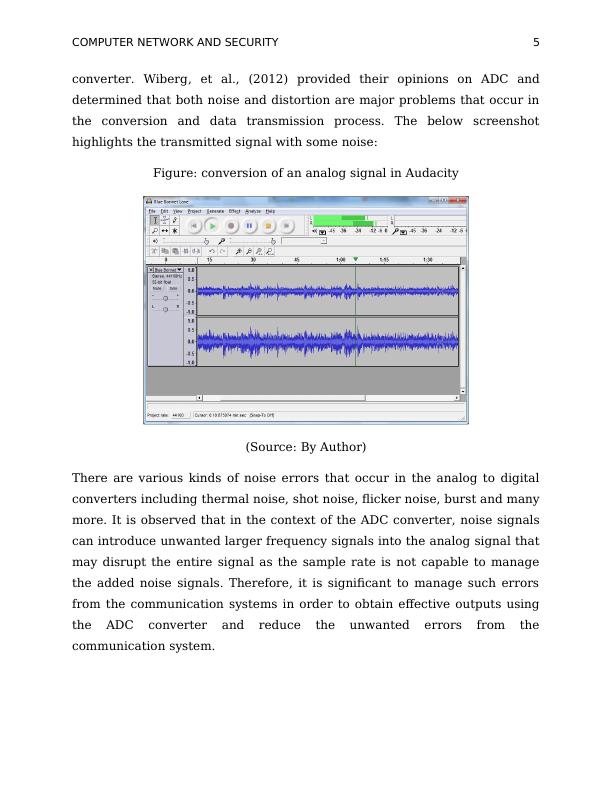
End of preview
Want to access all the pages? Upload your documents or become a member.
Related Documents
Functional Specification and Design of FM Radio Frequency Channelslg...
|11
|1378
|354
Wireless Networks and Communication Name of Student Institution Affiliation Question 1: Converting Binary Data into Analog Waveformslg...
|28
|1093
|200
Amplitude Modulation and Frequency Modulation Experiment - Assignmentlg...
|18
|2426
|90
7502ICT Advanced Networking Technology Assignmentlg...
|6
|5094
|347
Digital Encoding, Multiplexing Techniques and Network Communication Protocolslg...
|8
|1168
|438
Design of a Communication Link to Interconnect Two Locationslg...
|10
|2220
|189
